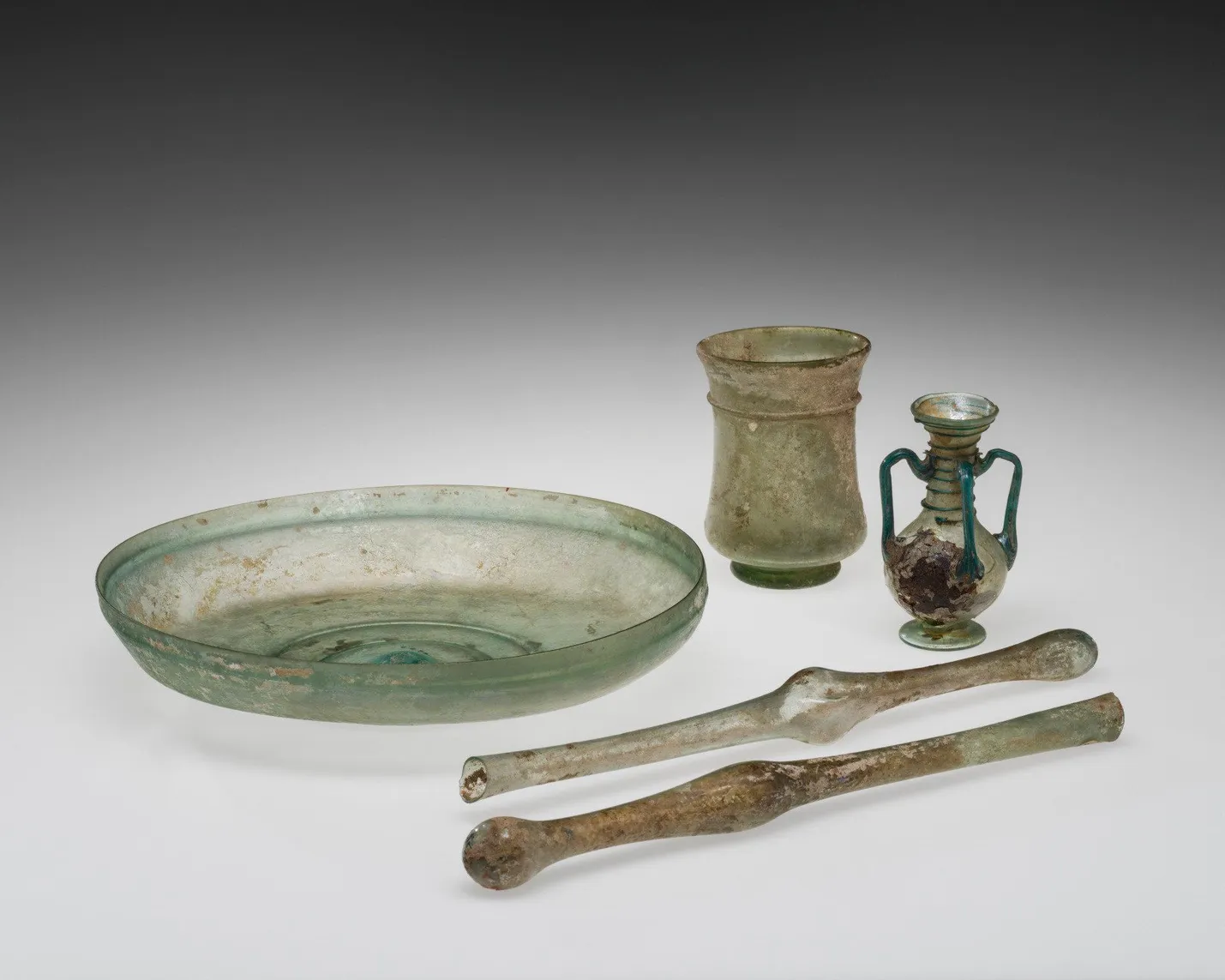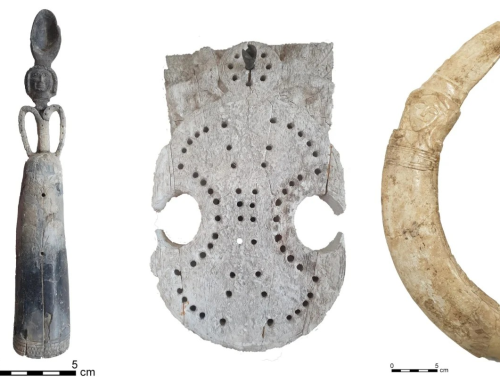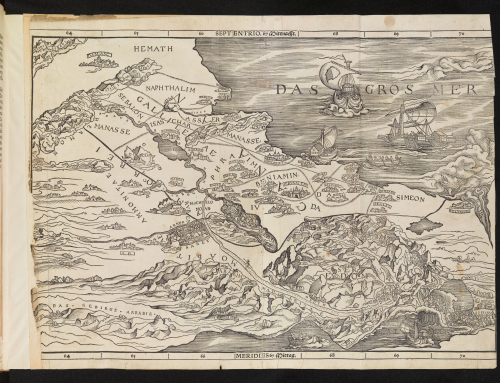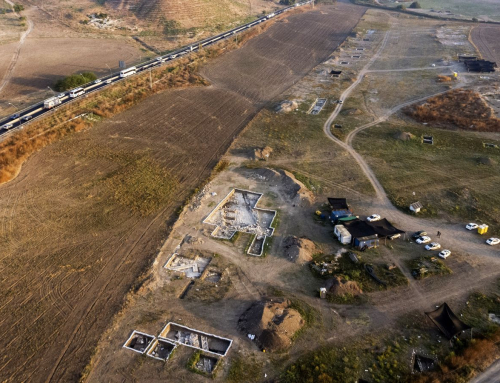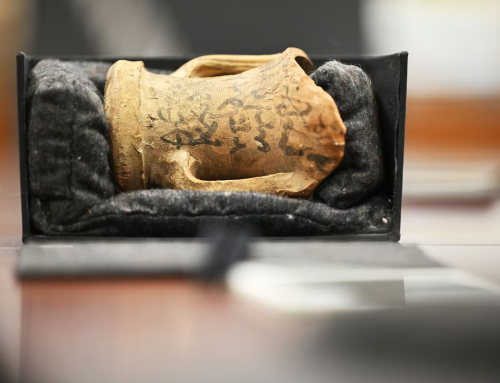Beneath Kishon Prison in northern Israel lies an ancient glassworks from the last days of the Roman Empire. Now, 1,600 years later, the world-famous Corning Museum of Glass is showcasing the ancient glass of Jalame in a special exhibition from May 13 to January 7.
The exhibition “Dig Deeper: Discovering an Ancient Glass Workshop,” to be held in the town of Corning, New York, celebrates the world of ancient glassmakers. It will feature permanent items at the museum and more than 50 pieces, some not from Jalame, provided by the Israel Antiquities Authority (and a comic book).
The factory at Jalame began operating in the fourth century, by which time glass was old hat. The earliest glass made by humans (not volcanoes or meteor strikes) dates to the third millennium B.C.E. The glassworks at Jalame was discovered in the 1960s.
Why is Corning now celebrating the glass industry of yore based on a workshop from the middle of the story of glass? And the workshop was an unremarkable one at that, operating on a remote hilltop in northern Israel during the sunset of the Romans.
Well, the excavation and the historical record at Jalame have become a textbook for scholars of ancient glass manufacturing, say Yael Gorin, head of glass at the Israel Antiquities Authority, and Katherine Larson, curator of ancient glass at Corning.
“Jalame was the first ancient glassworks ever to be excavated in an orderly fashion,” Gorin says. Also, the original excavation in the ’60s was of the ancient village at the top of the hill, which is now occupied by the prison and a parking lot for buses. In addition, new digging at the foot of the hill has exposed an unexpected facet of the industry’s story, Gorin adds.
A short break for war
In the ’60s, archaeologists from the University of Missouri and representatives from Corning, led by Gladys Davidson Weinberg, came to Israel looking for ancient glass.
Why would archaeologists come to Israel to search for Roman glassware factories and not, maybe, Italy? Mainly because history describes Israel as key to glass production in the ancient world.
In fact, the entire southern Levant coast and Egypt were key sources of the sand needed for Roman glassmaking. Not just any sand would do. And thus, the researchers targeted Israel for surveying, expecting glass production to be found, Larson says. And it was.
Their work broke for the 1967 Six-Day War, but they would go on to publish short reports in Israel and abroad. In 1988 they published the first proper report on any ancient glassworks, the paper that would become an example for archaeologists in this niche.
The delights of primary production
Glassmaking begins with primary production: melting source materials in large furnaces to produce chunks of raw glass. Then comes secondary production, which involves re-melting the glass in kilns for coloring, shaping and ultimately making nice things, including by glassblowing.
Based on the finds, the 1988 report concluded that Jalame did secondary production, which wouldn’t have been unusual. The archaeologists found thousands of pieces of glass debris highly specific to blowing glass, she says.
But was it really, all of it? Actually, in the ’60s, archaeologists didn’t know much about ancient primary glass production, Gorin says. Come the ’90s, she studied primary production in antiquity and, while revisiting the debris from Jalame stored at the Israel Museum, she thought, wait a minute.
First, in the ’60s, the Americans came across an oddly large room atop the hill but assumed it was associated with mass secondary production. Revisiting the data, Gorin realized that the mystery room had actually been devoted to primary production: making the raw glass. Gorin wrote her doctorate on this aspect of the Jalame operation in 2015.
Second, recent roadwork at the foot of the hill where the prison sits exposed more antiquities. The roadwork ground to a halt as excavations revealed four primary-production furnaces.
That, Gorin says, confirms her thesis that Jalame was a rare case of making its raw glass and consuming it too. “Jalame is one of the few locations we have from that period where both operations of glassmaking took place in the same place,” Larson says.
We the people are confused. If I make raw glass, I would reasonably produce the secondary product (blow it into bottles or whatever) at the same place. No?
Wonder sand
This leads us back to the wondrous sands of the Levantine coast. “Primary production is reliant on having the proper ingredients – sand, soda (natron) – and that’s why Egypt and the Levantine coast – Israel and Lebanon – were so important [in antiquity]: They had the right sand sources with adequate silica, and lime, which makes glass stable and not water-soluble,” Larson says.
“They had sources of sodium. So the Levant and Egypt produced raw glass throughout antiquity and shipped it throughout the Roman Empire – as far as Britain.”
Yes, there were glassblowing shops throughout the Roman Empire – every city had one – which would import the raw glass from the southern Levant and Egypt. They would handle the secondary production: melting the raw glass and forming it into kitchenware and other products.
Why? Because the big glass chunks were okay to ship and who cares if one breaks, unlike finished glass products. Thus the wonder sands of the Levant wound up in glass workshops in Britain, Italy, Germany and France – everywhere.
Note that Pliny the Elder, the great admiral and natural philosopher, extolled the sands of the Na’aman River (then called the Belus) in the context of glassmaking more than 2,000 years ago. In fact, Corning scientist Robert Brill concluded that the Jalame glass was probably made using sand from the Na’aman, which empties into Haifa Bay.
So Jalame produced raw glass that was sold throughout the Mediterranean, and also blew glass for local consumption. “It’s clear that glass was a major part of ancient Israel’s economy,” Larson says.
Failed glass at Beit She’arim
Note that Jalame was not glassmaking in splendid isolation.
Archaeologists have found dozens of ancient glassworks along Israel’s coast, some in the towns and some in the sticks, Larson says, but each would have been short-lived. “Glassworkers were probably moving down the road as frequently as every five or 10 years,” she says.
Why? Because they were using wood to fire their furnaces, and trees are a finite source in the Middle East. (A companion exhibition at the Corning Museum – “Get Stoked!” – will showcase fuel in the glassmaking process from antiquity to today.)
“Glass melts at 1,100 degrees Celsius, but it’s still stiff. When making raw glass, the hotter the better in order to get the sand and sodium to react, and it has to be kept melted for a sustained amount of time,” Larson explains.
In short, the glassmakers needed to fire the furnaces to over 1,200 degrees and keep them there for a while. So when the trees in the area were gone, the glassworks would move. Generally they went from north to south.
“By the seventh and eighth century C.E. we find glassworks in Apollonia,” Larson says, referring to the site of a Crusader castle just north of modern-day Tel Aviv. By the way, the Apollonia factory was bigger than Jalame’s and also lasted no more than 10 or 15 years.
So even though glass began 5,000 years ago, and even though many glassworks have since been found including at nearby Beit She’arim and yet others in Egypt and Syria and elsewhere, Jalame in northern Israel was one of the earliest sites that was “really well documented,” Larson says.
By the way, the glassworks at Beit She’arim was a failed enterprise, Larson notes. “They didn’t get the chemistry right, or the ratios,” she says. Archaeologists working there found a great big slab of something 3 meters long, 1 meter wide. Corning got involved in the testing and identification, and the slab turned out to be failed glass, Larson notes. So it goes.
So Corning has been involved with Jalame from the get-go of investigations at the site, though note that Kishon Prison was built (by the British) in 1934, so it was there first. Corning Museum also has pieces from that first excavation and, Larson says, she herself has been coming to Israel to work since 2003.
And all this is why the great Corning is showcasing Jalame, an ordinary glassworks from the middle of the story of glass that engaged both in primary and secondary production on a hilltop in northern Israel.
“Why Jalame of all places?” Gorin asks. “It’s the key site to understanding glass production in the Late Roman period. Every glass researcher knows the Jalame report – it’s a classic.” And for non-glass researchers, this one site can tell glass’ history.
The earliest glass
Let’s be clear that glass is found in nature.
Obsidian is volcanic glass produced when the ejecta – yes, the stuff ejected – is rich in silica. It’s a true glass that may have edges sharper than steel. Obsidian is usually black but sometimes takes hues from magnetite minerals: Rainbow obsidian is a rarity but it’s a thing.
Indeed, hominins over the eons have used obsidian and other volcanic rocks as knives; archaeologists in Israel even found an obsidian blade that originated in Turkey, at a 9,000-year-old Neolithic settlement near Jerusalem. (Israel has dormant volcanoes in the Golan Heights but no obsidian.) Glass pebbles called tektites are another natural form, created when a meteor slams into the ground, melts it and splashes debris into the air.
And perhaps about 5,000 years ago people began to make glass. “The earliest glass was probably accidental,” Gorin says, a by-product of using fire to make something else, maybe faience ceramic. Some sand melted and the rest is history – at Corning.
Apropos faience, while ceramics emerged as much as 20,000 years ago in the Far East, here in the Levant pottery techniques emerged around maybe 8,000 to 9,000 years ago.
So the very earliest glass found in archaeological contexts is from the third millennium B.C.E., but no more than maybe a dozen pieces have been found spanning 1,000 years, Larson says – which supports the theory that these pieces were accidental by-products.
The glass industry proper seems to have started in the 16th century B.C.E, in the transition from the Middle Bronze Age to the late one, probably in Egypt and maybe in Syria, northern Mesopotamia. Hittite glass has been found in Turkey, Larson notes.
Gorin adds: “For the first 1,500 years the technology was clumsy and the glass didn’t look like it does today. It was less colorful, less transparent. The transition to glass as we know it followed the development of glassblowing, which happened slightly before the first century B.C.E.”
Early glass was the prerogative of the highest elites. It would only become widely accessible in the Hellenistic and early Roman periods, from which raw glass ingots are found in shipwrecks along the coast.
The fourth century C.E., when Jalame housed a glassworks and not a jail, was one of transition from the Roman to the Byzantine period.
Time-wise, Gorin acknowledges, the factory could be dubbed Byzantine, but its material culture was strictly Late Roman – it didn’t make the wine vessels, windows and lamps of Byzantine style. It made Roman-type bowls, cups, beakers, bottles, cone-shaped cups and lamps of a type used in fourth-century synagogues.
Visitors to the exhibit can see for themselves what making glass in antiquity involved and even play a digital Jalame excavation game. The exhibit features a wood-fired glassblowing furnace and a film showing a re-creation of the processes – which, according to Pliny the Elder, actually emerged right there in northern Israel.
At the mouth of the Belus, Pliny the Elder wrote, “The beach stretches for not more than half a mile, and yet for many centuries the production of glass depended on this area alone. There is a story that once a ship belonging to some traders in natural soda put in here and that they scattered along the shore to prepare a meal.
“Since, however, no stones suitable for supporting their cauldrons were forthcoming, they rested them on lumps of soda from their cargo. When these became heated and were completely mingled with the sand on the beach a strange translucent liquid flowed forth in streams; and this, it is said, was the origin of glass.”
That’s probably myth, according to an article in the journal Antiquity. But if that wasn’t the precise event, it was probably something quite like it.
Original Article – Ancient Israel and the Origin of Roman Glass – Archaeology – Haaretz.com

